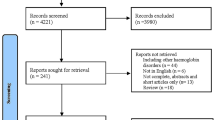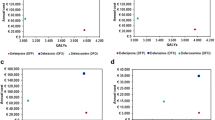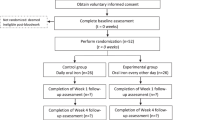Abstract
Introduction
This study of UK patients examines clinical, healthrelated quality of life (HRQOL) and economic outcomes associated with iron chelation therapy (ICT). Desferrioxamine (DFO) (Desferal®; Novartis, Switzerland) and Deferiprone (Ferriprox®; Apotex, Canada) are ICTs used to treat iron overload. DFO requires 8-to 12-hour infusions a minimum of five times per week. Deferiprone is administered in an oral daily regimen. Although pharmacologically efficacious, clinical effectiveness of ICT within the real-world setting is yet to be fully elucidated.
Methods
A naturalistic cohort study of 60 patients (betathalassaemia, n=40; sickle cell disease, n=14; myelodysplastic syndromes, n=6; 63% female) receiving ICT in four UK treatment centres was conducted. Serum ferritin level data were abstracted from medical charts. Compliance, HRQOL, satisfaction and resource utilisation data were collected from interviews. Maximum ICT costs were estimated using the resource utilisation data associated with DFO.
Results
Mean serum ferritin levels, generally, remained elevated despite ICT. Compliance was suboptimal and HRQOL scores were lower than population norms. The total estimated mean weighted annual per-patient cost of DFO treatment was approximately £19,000. DFO-related equipment, DFO drug, and home healthcare were estimated to account for 43%, 19% and 24% of costs, respectively. Other more minor components of total annual costs were for in-patient infusions, ICT home delivery services and monitoring costs.
Conclusion
Generally, patients are not achieving target serum ferritin thresholds despite chronic treatment for iron overload. ICT appears to negatively impact HRQOL; compliance with ICT is poor; and, in the case of DFO, treatment costs well exceed the cost of DFO alone. These results suggest that current ICT in the real-world setting is suboptimal with respect to various clinical, HRQOL and economic outcomes.
Similar content being viewed by others
References
Olivieri NF, Brittenham GM. Iron-chelating therapy and the treatment of thalassemia. Blood. 1997;89:739–761.
Harvard Medical School. Effects of iron overload: hemochromatosis, tranfusional iron overload. 2006. Available at: http://sickle.bwh.harvard.edu/index.html. Accessed June 2008.
Gabutti V, Piga A. Results of long-term iron-chelating therapy. Acta Haematol. 1996;95:26–36.
Vidler V. Compliance with iron chelation therapy in beta thalassaemia. Paediatr Nurs. 1998;10:17–18.
Rebulla P. Transfusion reactions in thalassemia. A survey from the Cooleycare programme. The Cooleycare Cooperative Group. Haematologica. 1990;75(suppl 5): 122–127.
Giardina PJ, Grady RW. Chelation therapy in beta-thalassemia: an optimistic update. Semin Hematol. 2001;38:360–366.
Alymara V, Bourantas D, Chaidos A, et al. Effectiveness and safety of combined ironchelation therapy with deferoxamine and deferiprone. Hematol J. 2004;5:475–479.
Shumaker SA, Berzon RA. The International Assessment of HRQL. Theory, Translations, Measurement and Analysis. Oxford: Rapid Communications; 1995.
Abetz L, Baladi JF, Jones P, Rofail D. The impact of iron overload and its treatment on quality of life: results from a literature review. Health Qual Life Outcomes. 2006;4:73.
Hasan SP, Hashmi S, Alhassen M, et al. Depression in sickle cell disease. J Natl Med Assoc. 2003;95:533–537.
Kornblith AB, Herndon JE, Silverman LR, et al. Impact of azacytidine on the quality of life of patients with myelodysplastic syndrome treated in a randomized phase III trial: a Cancer and Leukemia Group B study. J Clin Oncol. 2002;20:2441–2452.
Olivieri N, Brittenham GM, McLaren CE, et al. Long-term safety and effectivness of iron chelation therapy with deferiprone for thalassemia major. N Engl J Med. 1998;339:417–423.
Caro JJ, Huybrechts K, Green TC. Estimates of the effect on hepatic iron of oral deferiprone compared to subcutaneous desferrioxamine for treatment of iron overload in thalassaemia major: a systematic review. BMC Blood Disord. 2002;2:4.
Payne KA, Desrosiers MP, Caro JJ, et al. Clinical and economic burden of infused iron chelation therapy (ICT) in the United States. Transfusion. 2007;47:1820–1829.
Serjeant GR. Sickle-cell disease. Lancet. 1997;350:725–730.
Cazzola M, Malcovati L. Myelodysplastic syndromes-coping with ineffective hematopoiesis. N Engl J Med. 2005;352:536–538.
Ware JE, Sherbourne CD. The MOS 36-item short-form health survey (SF-36). I. Conceptual framework and item selection. Med Care. 1992;30:473–483.
Rofail D, Abetz L, Viala M, et al. Satisfaction and adherence in patients with iron overload receiving iron chelation therapy as assessed by a newly developed questionnaire. Value Health. 2008; Jul 11. Epub ahead of print.
Brazier J, Usherwood T, Harper R, Thomas K. Deriving a preference-based single index from the UK SF-36 Health Survey. J Clin Epidemiol. 1998;51:1115–1128.
Gold MR, Siegel JE, Russell LB, Weistein MC. Cost Effectiveness in Health and Medicine. Oxford: Oxford University Press; 1996.
Zeuner D, Ades A, Karnon J, et al. Antenatal and neonatal haemoglobinopathy screening in the UK: review and economic analysis. NHS Health Technol Assess Prog. 1999;3:1–186.
Wayne A, Schoenike S, Pegelow C, et al. Financial analysis of chronic transfusion for stroke prevention in sickle cell disease. Blood. 2000;96:2367–2369.
Karnon J, Zeuner D, Brown J, et al. Lifetime treatment cost of beta-thalassemia major. Clin Lab Haem. 1992;21:377–385.
Ginsberg G, Tulchinsky T, Filon D, et al. Cost-benefit analysis of a national thalassemia prevention programme in Israel. J Med Screen. 1998;5:120–126.
Jenkinson C, Stewart-Brown S, Petersen S. Assessment and Evaluation of the SF36 Version II. Health Services Research Unit: University of Oxford; 2006. Available at: www.hsru.ox.ac.uk/sf36v2.htm. Accessed 9 February 2006.
Gorodetskaya I, Zenios S, McCulloch CE, et al. Health-related quality of life and estimates of utility in chronic kidney disease. Kidney Int. 2005;68:2801–2808.
Brazier J, Roberts J, Deverill M. The estimation of a preference-based measure of health from the SF-36. J Health Econ. 2001;21:271–292.
Landgraf JM, Abetz L, Ware JE. The Child Health Questionnaire (CHQ): a User’s Manual. 2nd ed. Boston, MA: The Health Institute; 1996.
Medi-Scot web site. Available at: www.mediscot.co.uk. Accessed 18 September 2006.
Medicines and Healthcare Products Regulatory Agency. Market survey. Nonelectrically powered dispoable infusion devices. Report 05055. September 2005. Available at: www.pasa.nhs.uk/evaluation/docs/general_medical/Report_05055 pdf. Accessed 23 October 2006.
Williams Medical Supplies. Available at: www wmsplc.co.uk. Accessed 18 September 2006.
Modell B. Guidelines for the control of haemoglobin disorders. Report of the Sixth Annual Meeting of the WHO Working Group on Haemoglobinopathies, Cagliari, Sardinia, 8–9 April 1989. Geneva: World Health Organization; 2004.
Chan GC, Ng DM, Fong DY, et al. Comparison of subcutaneous infusion needles for transfusion-dependent thalassemia patients by the intrapersonal cross-over assessment model. Am J Hematol. 2004;76:398–404.
Curtis L, Netten A. Unit Costs of Health and Social Care 2005. The University of Kent, Personal Social Services Research Unit 202.
Olivieri NF, Nathan DG, MacMillan JH, et al. Survival in medically treated patients with homozygous beta thalassemia. N Engl J Med. 1994;331:574–578.
Telfer PT, Prestcott E, Holden S, et al. Hepatic iron concentration combined with long-term monitoring of serum ferritin to predict complications of iron overload in thalassaemia major. Br J Haematol. 2000;110:971–977.
Borgna-Pignatti C, Rugolotto S, De Stefano P, et al. Survival and complications in patients with thalassemia major treated with transfusion and deferoxamine. Haematologica. 2004;89:1187–1193.
Thalassemia International Federation web site. Guidelines for Clinical Management of Thalassemia. 2000. Available at: www. thalassaemia.org.cy/MyData/Books/Clinical_%20Management_Thalassaemia.pdf. Accessed June 2008.
Arboretti R, Tognoni G, Alberti D. Italian Collaborative Group on Thalassarmia. Pharmacosurveillance and quality of care of thalassaemic patients. A large scale epidemiological survey. Eur J Clin Pharmacol. 2001;56:915–922.
Taher A, Sheikh-Taha M, Koussa S, et al. Comparison between deferoxamine and deferiprone (L1) in iron-loaded thalassemia patients. Eur J Haematol. 2001;67:30–34.
Caro JJ, Ward A, Green TC, et al. Impact of thalassemia major on patients and their families. Acta Haematol. 2002;107: 150–157.
Ward A, Caro JJ, Green TC, et al. An international survey of patients with thalassemia major and their views about sustaining life-long desferrioxamine use. BMC Clin Pharmacol. 2002;2:3.
Cunningham MJ, Macklin EA, Neufeld EJ, Cohen AR. Complications of betathalassemia major in North America. Blood. 2004;104:34–39.
Kosinski M, Zhao SZ, Dedhiya S, et al. Determining minimally important changes in generic and disease-specific health-related quality of life questionnaires in clinical trials of rheumatoid arthritis. Arthritis Rheum. 2000;43:1478–1487.
Samsa G, Edelman D, Rothman ML, et al. Determining clinically important differences in health status measures: a general approach with illustration to the Health Utilities Index Mark II. Pharmacoeconomics. 1999;15: 141–155.
Williams JJ, Calnan M. Convergence and divergence: assessing criteria of consumer satisfaction across general practice, dental, and hospital care settings. Soc Sci Med. 1991;33:707–716.
Author information
Authors and Affiliations
Corresponding author
Rights and permissions
About this article
Cite this article
Payne, K.A., Rofail, D., Baladi, JF. et al. Iron chelation therapy: Clinical effectiveness, economic burden and quality of life in patients with iron overload. Adv Therapy 25, 725–742 (2008). https://doi.org/10.1007/s12325-008-0085-z
Published:
Issue Date:
DOI: https://doi.org/10.1007/s12325-008-0085-z




